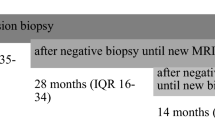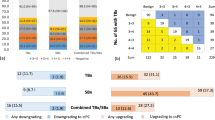Abstract
Background
Based on the findings of different trials in biopsy naïve patients, target biopsy (TB) plus random biopsy (RB) during mpMRI-guided transrectal ultrasound fusion biopsy (FB) are often also adopted for the biopsy performed during active surveillance (AS) programs. At the moment, a clear consensus on the extent and modalities of the procedure is lacking.
Objective
To evaluate the increase in diagnostic accuracy achieved by perilesional biopsy (PL) and different RB schemes during FB performed in AS protocol.
Design, setting, and participants
We collected prospectively the data of 112 consecutive patients with low- or very-low-risk prostate cancer; positive mpMRI underwent biopsy at a single academic institution in the context of an AS protocol.
Intervention(s)
mpMRI/transrectal US FB with Hitachi RVS system with 3 TB and concurrent transrectal 24-core RB.
Outcome measurements and statistical analysis
The diagnostic yield of the different possible biopsy schemes (TB only; TB + 4 perilesional (PL) cores; TB + 12-core RB; TB + 24-core RB) was compared by the McNemar test. Univariable and multivariable regression analyses were adopted to identify predictors of any cancer, Gleason grade group (GGG) ≥2 cancers, and the presence of GGG≥2 cancers in the larger schemes only.
Results and limitations
The detection rate of GGG ≥2 cancers increased to 30%, 39%, and 49% by adding 4 PL cores, 14, and 24 RB cores, respectively, to TB cores (all p values <0.01). On the whole, TB alone, 14-core RB, and 24-core-RB identified 38%, 47%, and 56% of all the GGG ≥2 cancers. Such figures increased to 62% by adding to TB 4 PL cores, and to 80% by adding 14 RB cores. Most of the differences were observed in PI-RADS 4 lesions.
Conclusions
We found that PL biopsy increased the detection rate of GGG ≥2 cancers as compared with TB alone. However, the combination of those cores missed a large percentage of the CS cancers identified with larger RB cores, including a 20% of CS cancers diagnosed only by the combination of TB plus 24-core RB.
This is a preview of subscription content, access via your institution
Access options
Subscribe to this journal
Receive 4 print issues and online access
$259.00 per year
only $64.75 per issue
Buy this article
- Purchase on Springer Link
- Instant access to full article PDF
Prices may be subject to local taxes which are calculated during checkout

Similar content being viewed by others
Data availability
The data that support the findings of this study are available from the corresponding author, upon reasonable request.
References
Ahmed HU, El-Shater Bosaily A, Brown LC, Gabe R, Kaplan R, Parmar MK.PROMIS study group, et al. Diagnostic accuracy of multi-parametric MRI and TRUS biopsy in prostate cancer (PROMIS): a paired validating confirmatory study. Lancet. 2017;389:815–22.
Kasivisvanathan V, Rannikko AS, Borghi M, Panebianco V, Mynderse LA, Vaarala MH, PRECISION Study Group Collaborators, et al. MRI-targeted or standard biopsy for prostate-cancer diagnosis. N Engl J Med. 2018;378:1767–77.
Rouvière, Puech O, Renard P, Penna R, Claudon M, Roy C, MRI-FIRST Investigators, et al. Use of prostate systematic and targeted biopsy on the basis of multiparametric MRI in biopsy-naive patients (MRI-FIRST): a prospective, multicentre, paired diagnostic study. Lancet Oncol. 2019;20:100–9.
Mottet N, van den Bergh RCN, Briers E, Van den Broeck T, Cumberbatch MG, De Santis M, et al. EAU-EANM-ESTRO-ESUR-SIOG guidelines on prostate cancer-2020 update. Part 1: screening, diagnosis, and local treatment with curative intent. Eur Urol. 2021;79:243–62.
Klotz L, Loblaw A, Sugar L, Moussa M, Berman DM, Van der Kwast T, et al. Active surveillance magnetic resonance imaging study (ASIST): results of a randomized multicenter prospective trial. Eur Urol. 2019;75:300–9.
Klotz L, Pond G, Loblaw A, Sugar L, Moussa M, Berman D, et al. Randomized study of systematic biopsy versus magnetic resonance imaging and targeted and systematic biopsy in men on active surveillance (ASIST): 2-year postbiopsy follow-up. Eur Urol. 2020;77:311–7.
Schiavina R, Droghetti M, Novara G, Bianchi L, Gaudiano C, Panebianco V, et al. The role of multiparametric MRI in active surveillance for low-risk prostate cancer: the ROMAS randomized controlled trial. Urol Oncol. 2021;39:433.e1–433.e7.
Schoots IG, Nieboer D, Giganti F, Moore CM, Bangma CH, Roobol MJ. Is magnetic resonance imaging-targeted biopsy a useful addition to systematic confirmatory biopsy in men on active surveillance for low-risk prostate cancer? A systematic review and meta-analysis. BJU Int. 2018;122:946–58.
Bryk DJ, Llukani E, Taneja SS, Rosenkrantz AB, Huang WC, Lepor H. The role of ipsilateral and contralateral transrectal ultrasound-guided systematic prostate biopsy in men with unilateral magnetic resonance imaging lesion undergoing magnetic resonance imaging-ultrasound fusion-targeted prostate biopsy. Urology. 2017;102:178–82. https://doi.org/10.1016/j.urology.2016.11.017.
Tschirdewahn S, Wiesenfarth M, Bonekamp D, Püllen L, Reis H, Panic A, et al. Detection of significant prostate cancer using target saturation in transperineal magnetic resonance imaging/transrectal ultrasonography-fusion biopsy. Eur Urol Focus. 2021;7:1300–7.
Brisbane WG, Priester AM, Ballon J, Kwan L, Delfin MK, Felker ER, et al. Targeted Prostate Biopsy: Umbra, Penumbra, and Value of Perilesional Sampling. Eur Urol. 2022;82:303–10.
Moore CM, Giganti F, Albertsen P, Allen C, Bangma C, Briganti A, et al. Reporting magnetic resonance imaging in men on active surveillance for prostate cancer: the PRECISE recommendations-a report of a european school of oncology task force. Eur Urol. 2017;71:648–55.
Novara G, Zattoni F, Zecchini G, Aceti A, Pellizzari A, Ferraioli G, et al. Role of targeted biopsy, perilesional biopsy, and random biopsy in prostate cancer diagnosis by mpMRI/transrectal ultrasonography fusion biopsy. World J Urol. 2023;20. https://doi.org/10.1007/s00345-023-04382-3.
Weinreb JC, Barentsz JO, Choyke PL, Cornud F, Haider MA, Macura KJ, et al. PI-RADS prostate imaging - reporting and data system: 2015, Version 2. Eur Urol. 2016;69:16–40.
Abdollah F, Novara G, Briganti A, Scattoni V, Raber M, Roscigno M, et al. Trans-rectal versus trans-perineal saturation rebiopsy of the prostate: is there a difference in cancer detection rate? Urology. 2011;77:921–5.
Epstein JI, Egevad L, Amin MB, Delahunt B, Srigley JR, Humphrey PA, et al. The 2014 International Society of Urological Pathology (ISUP) Consensus Conference on Gleason Grading of Prostatic Carcinoma: definition of grading patterns and proposal for a new grading system. Am J Surg Pathol. 2016;40:244–52.
van den Bergh RC, Roemeling S, Roobol MJ, Roobol W, Schröder FH, Bangma CH. Prospective validation of active surveillance in prostate cancer: the PRIAS study. Eur Urol. 2007;52:1560–3.
Luiting HB, Remmers S, Valdagni R, Boevé ER, Staerman F, Rueb J, PRIAS consortium, et al. What is the effect of MRI with targeted biopsies on the rate of patients discontinuing active surveillance? A reflection of the use of MRI in the PRIAS study. Prostate Cancer Prostatic Dis. 2021;24:1048–54.
Shapiro DD, Gregg JR, Lim AH, Nogueras-González GM, Choi H, Kang HC, et al. Comparing confirmatory biopsy outcomes between MRI-targeted biopsy and standard systematic biopsy among men being enrolled in prostate cancer active surveillance. BJU Int. 2021;127:340–8.
Yerram NK, Long L, O’Connor LP, Wang AZ, Ahdoot M, Lebastchi AH, et al. Magnetic resonance imaging-targeted and systematic biopsy for detection of grade progression in patients on active surveillance for prostate cancer. J Urol. 2021;205:1352–60.
Van der Leest M, Cornel E, Israël B, Hendriks R, Padhani AR, Hoogenboom M, et al. Head-to-head comparison of transrectal ultrasound-guided prostate biopsy versus multiparametric prostate resonance imaging with subsequent magnetic resonance-guided biopsy in biopsy-naïve men with elevated prostate-specific antigen: a large prospective multicenter clinical study. Eur Urol. 2019;75:570–8. https://doi.org/10.1016/j.eururo.2018.11.023.
Hansen NL, Barrett T, Lloyd T, Warren A, Samel C, Bratt O, et al. Optimising the number of cores for magnetic resonance imaging-guided targeted and systematic transperineal prostate biopsy. BJU Int. 2020;125:260–9.
Jones JS, Patel A, Schoenfield L, Rabets JC, Zippe CD, Magi-Galluzzi C. Saturation technique does not improve cancer detection as an initial prostate biopsy strategy. J Urol. 2006;175:485–8.
Scattoni V, Zlotta A, Montironi R, Schulman C, Rigatti P, Montorsi F. Extended and saturation prostatic biopsy in the diagnosis and characterization of prostate cancer: a critical analysis of the literature. Eur Urol. 2007;52:1309–22.
de la Taille A, Antiphon P, Salomon L, Cherfan M, Porcher R, Hoznek A, et al. Prospective evaluation of a 21-sample needle biopsy procedure designed to improve the prostate cancer detection rate. Urology. 2003;61:1181–6.
Johnson DC, Raman S, Mirak S, Kwan L, Bajgiran AM, Hsu W, et al. Detection of individual prostate cancer foci via multiparametric magnetic resonance imaging. Eur Urol. 2019;ume 75:712–20.
Loeb S, Bruinsma SM, Nicholson J, Briganti A, Pickles T, Kakehi Y, et al. Active surveillance for prostate cancer: a systematic review of clinicopathologic variables and biomarkers for risk stratification. Eur Urol. 2015;67:619–26.
Press BH, Jones T, Olawoyin O, Lokeshwar SD, Rahman SN, Khajir G, et al. Association between a 22-feature genomic classifier and biopsy gleason upgrade during active surveillance for prostate cancer. Eur Urol Open Sci. 2022;37:113–9.
Olivier J, Li W, Nieboer D, Helleman J, Roobol M, Gnanapragasam V. Movember Foundation’s Global Action Plan Prostate Cancer Active Surveillance GAP3 Consortium, et al. Prostate cancer patients under active surveillance with a suspicious magnetic resonance imaging finding are at increased risk of needing treatment: results of the Movember Foundation’s Global Action Plan Prostate Cancer Active Surveillance (GAP3) Consortium. Eur Urol Open Sci. 2022;35:59–67.
Rajwa P, Pradere B, Quhal F, Mori K, Laukhtina E, Huebner NA, et al. Reliability of serial prostate magnetic resonance imaging to detect prostate cancer progression during active surveillance: a systematic review and meta-analysis. Eur Urol. 2021;80:549–63.
Author information
Authors and Affiliations
Contributions
The authors confirm contribution to the paper as follows: GN, FZ and FDM; conceptualization, critical review, and revisions for this manuscript. GZ, AA, AP, GF, CC, AT, FS, FC, GLB collected the data. GSL, AL, MG, AM and GB; analysis and interpretation of results.
Corresponding author
Ethics declarations
Competing interests
The authors declare no competing interests.
Additional information
Publisher’s note Springer Nature remains neutral with regard to jurisdictional claims in published maps and institutional affiliations.
Supplementary information
Rights and permissions
Springer Nature or its licensor (e.g. a society or other partner) holds exclusive rights to this article under a publishing agreement with the author(s) or other rightsholder(s); author self-archiving of the accepted manuscript version of this article is solely governed by the terms of such publishing agreement and applicable law.
About this article
Cite this article
Novara, G., Zattoni, F., Zecchini, G. et al. Role of targeted biopsy, perilesional biopsy, random biopsy, and their combination in the detection of clinically significant prostate cancer by mpMRI/transrectal ultrasonography fusion biopsy in confirmatory biopsy during active surveillance program. Prostate Cancer Prostatic Dis 27, 129–135 (2024). https://doi.org/10.1038/s41391-023-00733-8
Received:
Revised:
Accepted:
Published:
Issue Date:
DOI: https://doi.org/10.1038/s41391-023-00733-8
This article is cited by
-
Best of 2023 in Prostate Cancer and Prostatic Diseases
Prostate Cancer and Prostatic Diseases (2024)



